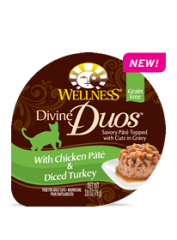If you’ve read my blog, you already know that I support a canned food diet only for cats. Why? In short, a high protein, low-carbohydrate diet is most suited for a cat’s natural digestive system. Cats lack certain enzymes that humans and dogs (omnivores) do, that allow them to process carbohydrates. All dry food diets are high in carbohydrates, because they need starches (whether it be from grains, potatoes, or other vegetables) to bind the kibble. Below are some websites for further reading:
PetMD
“We purchase convenient, attractively packaged and preserved dry foods mainly because we can pour it in the bowl and forget it. Dry pet food must have higher levels of flour and sugar than canned foods so that the kibble will stay uniform and not fall apart. Spoiling doesn’t readily occur because of the preservatives so the kitty can eat whenever it wants and we don’t have to prepare cat meals very often. Unfortunately, especially with dry diets, because of the metabolic biochemistry that converts the high carbohydrate content in almost all of today’s commercial cat foods into stored fat, the cat is really at risk for weight gain.”
HealthyPets
“The UC-Davis researchers concluded canned (wet) diets result in cats voluntarily eating less and a corresponding reduction in body weight. Further, nutritional content and digestibility are not compromised, which is a big concern with low fat/weight loss dry cat food formulas.”
CatInfo.org – my FAVORITE feline nutrition website that I frequently quote
“This is why the statement “but my cat is healthy/fine on dry food” means very little to me because I believe in preventative nutrition – not locking the barn door after the horse is gone. I don’t want to end up saying “oops……I guess he is not so fine now!!” when a patient presents to me with a medical problem that could have been avoided if he would have been feed a species-appropriate diet to begin with.
Your Diabetic Cat
“Feline diabetes is not the natural fate of hundreds of thousands of pet cats world-wide. It is, rather, a human-created disease that is reaching epidemic proportions because of the highly artificial foods that we have been feeding our feline companions for the past few decades. Without the constant feeding of highly processed, high carbohydrate dry foods, better suited to cattle than cats, adult-onset feline diabetes would be a rare disease, if it occured at all.”
FelineNutrition.org
“What has not been established is whether cats can do more than survive, in poor or deteriorating health, on a dry, grain-based, biologically inappropriate diet. How, then, did we come to this practice that seems to make little sense? We probably never thought about it. Nor did the people before us who first accepted kibble and grain-based canned foods as replacements for the cat meats and scraps they fed their cats.”












